How to Break Up a Dog Fight Without Getting Hurt
** This article contains graphic photos of dog bites. If you find yourself uncomfortable with these photos, please listen to our podcast or watch our video instead.
Breaking up a dog fight can go bad in a heartbeat. This is serious business. So know your limitations and don't get into the middle of something you can't physically deal with.
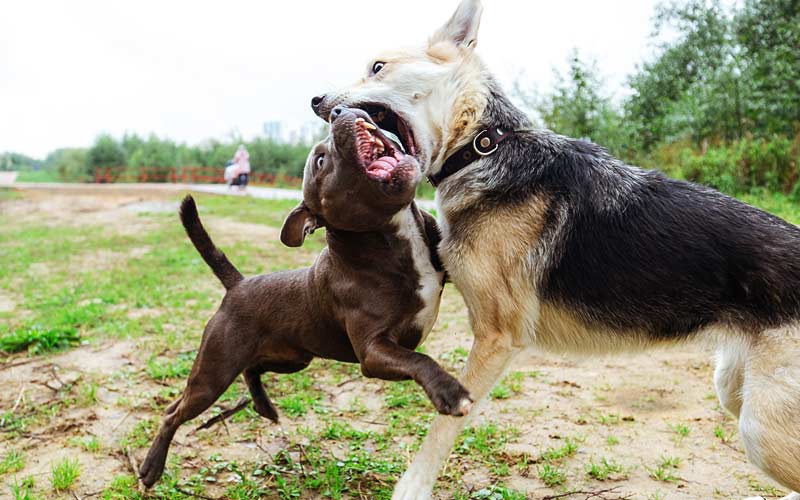
This past week I had an incident at my kennel that reminds me how important it is for everyone who works with dogs or owns dogs to know how to break up a dogfight without getting hurt.
I will start with a warning. Unless you have a lot of experience do not try and break up a dog fight by yourself. Never step in the middle of two loving pets and try and grab them by the collar to stop a dog fight. If you try this, the chances of you being badly bitten are extremely high. People don't understand that 2 animals in the middle of a fight are in survival drive. If they see you at all, they don't look at you as their loving owner. When you charge in and grab them, they either react out of a fight reflex and bite, or they see you as another aggressor. When they are in fight or flight mode, they will bite you. You can take that to the bank.
Here is what happened at my kennel this week: The wife of a friend came to the kennel with her daughter. She told my secretaries that I had said it was OK to go into my whelping rooms to show her little girl our puppies.
I had never told her this. Anyway, that does not matter. When she left, she did not latch one of the kennel gates properly (this was also an employee mistake for not checking the gate).
Later, one of my kennel staff let another bitch outside. The first bitch jumped against her poorly latched kennel gate, and it came open. She ran outside and started a terrible dog fight. I had not told this young kennel person how to break up a dog fight in progress. He ran in and tried to grab both dog collars. He was bitten very badly in the forearm and hand before I could get to the scene and break up the dog fight the correct way.
The Safest Option Requires Two People
The safest way to break up a dogfight requires two people. Each person grabs the back feet of one of the dogs. The dog's back feet are then picked up like a wheelbarrow. With the legs up, both dogs are then pulled apart.
Once the dog fight is broken up and the dogs pulled apart, it is critical that the people do not release the dogs or the dog fight will begin again. The two people need to start turning in a circle, or slowly swinging the dogs in a circle while they back away from the other dog. This stops the dog from curling and coming back and biting the person holding their legs.
By circling, the dog has to sidestep with its front feet or it will fall on its chin. As long as you slowly continue to back away and circle, the dog cannot do any damage to you. To ensure that the fight will not begin all over again when you release the dogs, one of the dogs needs to be dragged into an enclosure (i.e. a kennel, the garage, another room) before the dog is released. If you do not do this, the dog will often charge back and start fighting again, or if you release the dog too quickly, the dog will turn and attack the person who had his feet.
Dog fights are a very dangerous thing to try and break up alone. You should never rush in and try and grab the dogs to pull them apart. They are in high "fight drive" and are not thinking clearly when fighting. If someone grabs them, they will bite without even thinking about who or what they are biting. This is how your loving pet can dog bite the living crap out of you in about a second and a half.
In reality, it probably doesn't even know it's biting you. I compare it to a bar fight. If a person comes up behind 2 guys fighting and just reaches out and grabs the shoulder of one of the combatants most of the time the fighter is going to turn and throw a punch without even looking at who or what he is hitting. This is because his adrenaline is pumping and he is in "fight drive".
What To Do If You Are Alone
The worst case scenario is that you are alone when a serious fight breaks out. There are a couple things that you must keep in mind:
- Keep your cool you have a job to do.
- Do not waste time screaming at the dogs. It hardly ever works.
- Your goal is still the same; you must break up the fight without getting hurt.
- Go get a leash (allow the fight to continue while you do this).
- Dogs are almost always locked onto one another. Walk up and loop the leash around the back loin of the dog by either threading the leash through the handle or use the clip. I prefer the thread method.
- Now slowly back away and drag the dog to a fence or to an object that you can tie the leash to. By doing this, you effectively create an anchor for one of the dogs.
- Then walk around and grab the back legs of the second dog and drag it away from the dog that is tied up.
- Remember to turn and circle as they release.
- Drag the dog into a dog pen or another room before you release the back legs.
- Go back and take the dog off the fence and put him or her into a dog kennel.
- Sit down and have a stiff drink (or two).
A Demonstration on Breaking up a Dog Fight
Below, I've created a video on how to break up a dog fight. Seeing it visually will help you mentally prepare if you ever encounter a dog fight. Share it with everyone you know. It never hurts to be prepared. (Demonstration starts at 05:03.)
What Not To Do
People talk about using cattle prods or shock collars to break up 2 pets that fight. I can tell you that many times this is not going to work. The electric cattle prod or electric collar will only put the dogs into higher fight drive. When they are shocked, they will turn and bite the prod, or when they are shocked, they will think the other dog is causing the pain and they will fight harder. An electric collar is best used in conditioning training, but not during an actual dogfight.
I had a friend tell me that using a stun gun works. Not to shock the dog, but just to hold it in your hand and allow it to snap. The sound of the electrical snap is supposed to cause the dogs to stop fighting. I would be surprised if this worked.
A point I would like to make is that if you see two dogs out there squaring off through body posturing (i.e., one dog with stiff legs and tail straight up in the air putting his head over the shoulders of the other to show dominance), do not run out there screaming "NO! NO! NO!" Most of the time, this is going to trigger the fight. A lot of times, dogs will posture and one will give in and back away. They settle their dominance issue without a battle. I NEVER, NEVER, NEVER recommend testing this situation. It's not worth the fight that erupts if you are wrong. But I can tell you of a couple of situations at my kennel where I went outside, and 2 males were loose that I would have thought would fight to the death. Obviously, they determined that today is not the day to argue. I also know that had I gone out screaming before they settled it themselves, there would have been a nasty fight.
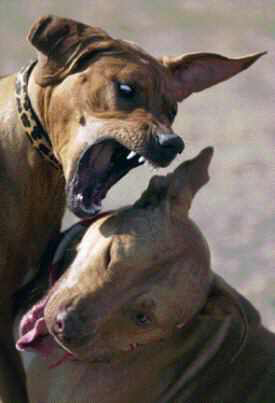
Living with Two or More Dogs
If you have 2 or more dogs that you are trying to get to live together, it's best to make them wear muzzles all the time. Try the Jafco muzzles I sell. They are not expensive but very effective for this work.
With muzzles on, you can test your training and if the dogs become aggressive, you can safely step in and correct the dogs. It's important to make sure the muzzles are properly fit and on securely. It's also a good idea to have the dogs wear 18-inch draglines.
When one of the dogs even acts like it is going to challenge the other dog, you need to INSTANTLY get after that dog. You're the pack leader and pack leaders are the ones who determine when to fight or be aggressive.
Read my articles on Introducing a New Dog into a Home with Other Dogs and The Groundwork to Establishing Pack Structure with Adult Dogs for in-depth instructions on achieving a healthy home environment with multiple dogs.
Stopping Continued Aggression
If dogs continue to show aggression, I will use a remote collar in its training. I did a training DVD that teaches Remote Collar Training for Pet Owners. With serious dog aggression, a dog needs to receive high-level stimulation for even looking at another dog. The key is for your timing to be for LOOKING and not for AGGRESSION. Many times, by the time a dog has elevated to the point of aggression, it will not react to normal levels of stimulation.
People make mistakes with remote collars and dog aggression by starting at a low level of stimulation and then waiting until the dog is actually being aggressive to stimulate the dog. By that time, the dog is so keyed up, it will fight through the correction. With many dogs, they learn how to take higher and higher levels of stimulation whereas had the owner used the highest level at first, they can often quickly go to lower levels.

Some Things to Keep In Mind
Remember that females usually fight with females and males usually fight with males. It's seldom that a male and female will fight. When a male fights with a female, it is usually a very dominant male who is displaying his dominance over the female and she wants nothing to do with it. I have had to gas one of my stud dogs twice when he got into it with a female who did not want anything to do with him. This usually is going to happen with a dominant male who is very self-confident and thinks that he is the pack leader. You will also have males with strong sex drive go after a bitch that is not receptive to them.
The bottom line on dog fights is that unless you are trained, it is best to never step into the middle of them. In the worst case, let them fight. It may result in death or severe injury to one of the dogs, but it's not worth the damage it could cause to you if you make a mistake trying to end the fight.
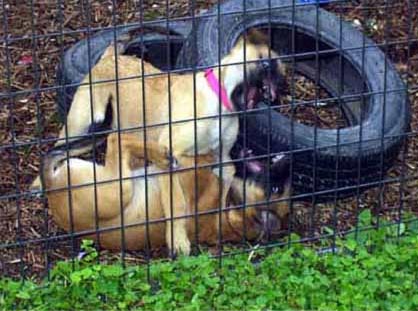
Dog Bites
A last word of warning. If you or someone you are with gets bitten and has to go to the emergency room, the most common treatment is to leave the dog bite wounds open so they can drain. They normally should not be stitched. The only time most doctors will stitch up a dog bite is if it's on the face. By closing the wound there is a much higher chance of infection. If the doctor that you see wants to stitch normal puncture wounds, ask for a second opinion. Because of my experience with police dogs I knew better than to allow my hospitals Physician Assistants to stitch my employee. I voiced my concern but she insisted on stitching. I should have asked for a doctor's opinion. The wounds got infected and we had him back in the emergency room (at a different hospital) 2 days later. They took the stitches out, inserted packing and put him on "IV's" with antibiotics.
A final note to this article. I have received a great many emails about dog fighting. Many were well meaning with ideas of how to use a hose and squirt water on the dog etc. While I appreciate these thoughts, the methods are simply not going to work on the very hard, very tough, working dog.
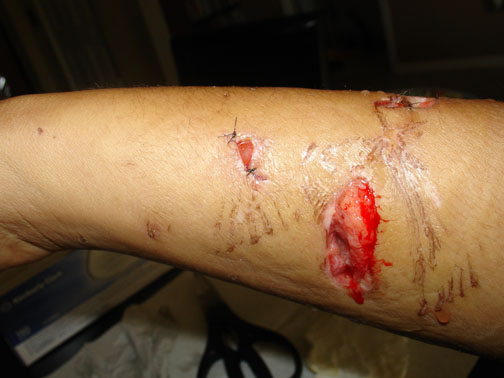
Basic Dog Obedience
The best way to eliminate dog fights is to never let them happen in the first place. This is accomplished by controlling the environment you take your dog to and then train your dog to mind under extreme distraction. If you cannot call your dog back when it is walking or running toward another dog, then your dog is not fully trained.
Read the article I wrote on dog parks. If you are a new dog owner, you need to learn why dog parks are a terrible idea and why they are a very dangerous place to take your dog.
I have produced a DVD on Basic Dog Obedience that teaches you how to train your dog (also available as an online course). If you are taking your training seriously, we also have Intermediate Dog Obedience available both as a DVD and as a course as well..
Resources on Training Aggressive Dogs
- Dealing with Dominant & Aggressive Dogs: Online course with over 19 hours of detailed lecture videos.
- Basic Dog Obedience: 4 hours. Obedience training needs to be part of the solution to dog aggression. With that said it's not the only solution. I tell people it's about 25% of the solution. The problem is if that 25% is not addressed you will never solve your problem.
- Intermediate Dog Obedience: 3+ hours. Our Intermediate Dog Obedience DVD is the next level for trainers who have watched our Basic Dog Obedience DVD or have taken the online course. In Basic Dog Obedience, we covered the foundation for our reward-based training system. In this DVD, we use that information to teach a number of behaviors that that are used in daily life.
- Remote Collar Training for the Pet Owner: 4 hours, 40 minutes. This DVD teaches pet owners who have never owned an electric collar how to condition their dog to the collar, how to determine the working level of stimulation to use on their dog (every dog is different) and then there is a detailed step by step section on how to train a dog with an electric collar.
- Establishing Pack Structure with the Family Pet: The goal of this 4-hour training DVD is a calm, submissive dog. Our pack structure training program aims to produce a dog that is calm and submissive and a dog that follows the rules of the pack leader. This DVD teaches people how to become a pack leader that their dog respects and loves.





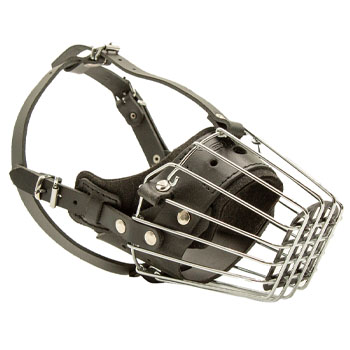
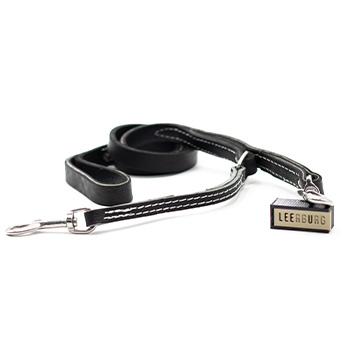


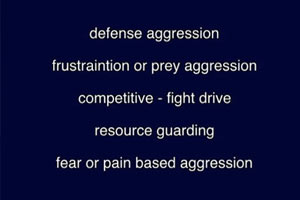
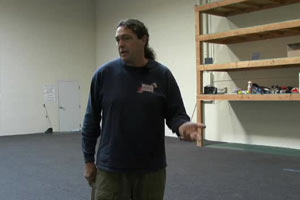

Ask Cindy.